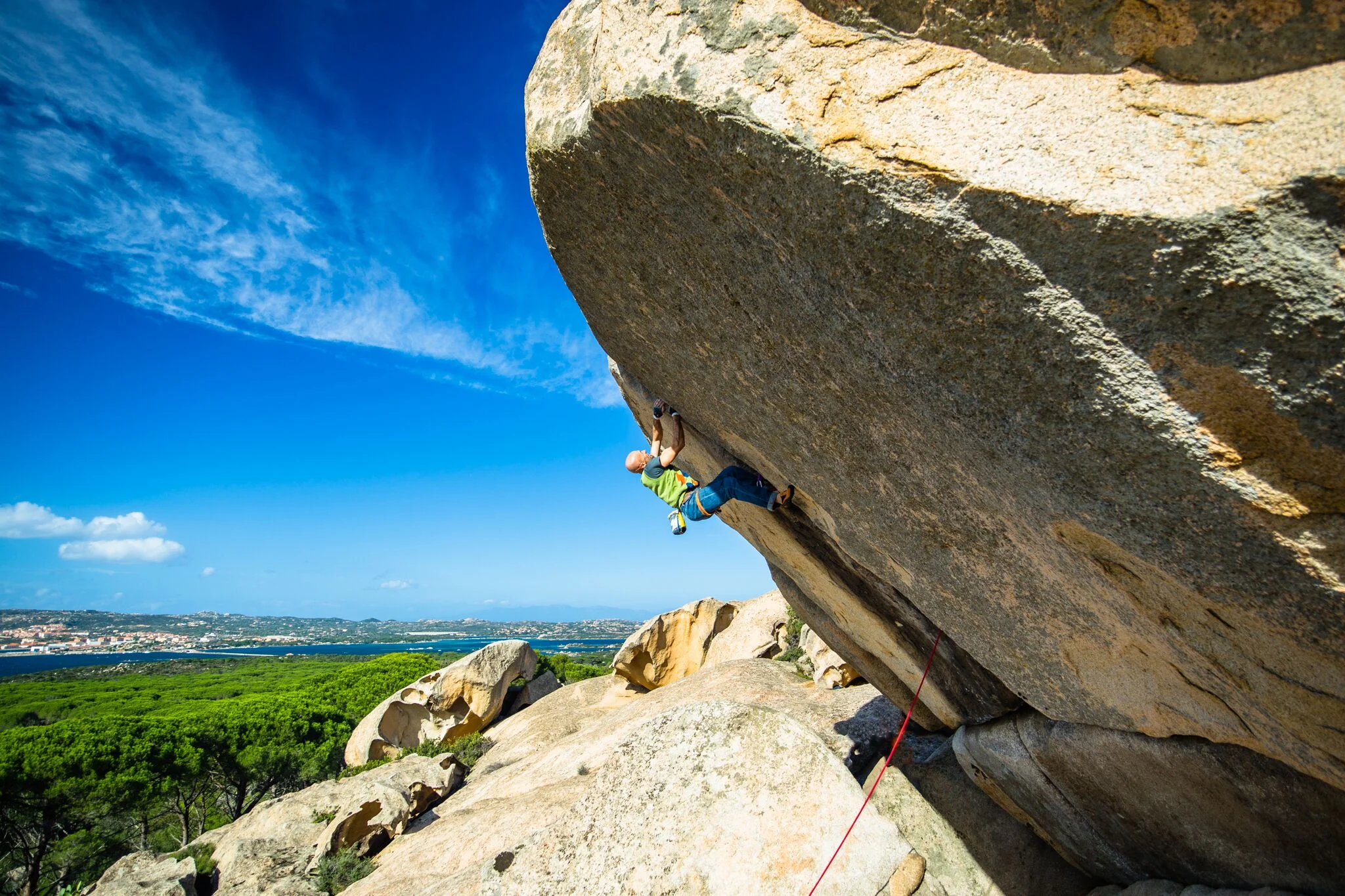How to Take Great Climbing Photos - Best Tips from Pros (Part 1)
With the rise of social media, there are now hundreds and hundreds of climbing photos going up every day.
I’m not gonna lie, most of them suck.
Before the age of smartphone photography, you had to go out and find photos of climbing in magazines. There, the photographers were putting a tonne of skill and effort into their craft and it was evident.
Where the hell has that gone? It’s not on #rockclimbing on Instagram!
So I’ve searched high and low for the few individuals who are actually still making an effort in the industry and gathered their top tips for taking a climbing photo.
Check out the advice of some of the best climbing photographers below and stay tuned for the second part with more tips and stunning photos!
Find something to capitalize on.
Coleman Becker - Capturing the life of the rock climber and what they will do for their sport is what I strive to accomplish in each photo. I have found that there are few sports that pit man against nature as well as climbing.
"Whenever I come across a beautiful photo opportunity, I am looking for an open space. I want separation, color, shapes and a spot to put a climber.
Those are my must do’s before I consider taking a shot - even though there is more to think about than that.
The way I like to grab attention from my audience will depend on where I am shooting. For example if I were in Alaska where the snow capped mountains behind the bouldering is so prevalent I would want to show them off.
Or if the climb the athlete is on is beautifully textured I would want to capitalize on that and zoom in to the climber.
When I have found those few things, the lens is the next factor. Thats where bringing too many lenses with me makes my photography work. I get to have options.
Shooting one photo with multiple lenses helps train my eye to see what situation is better for what lens and makes me a more confident photographer."
Composition before anything else - lines
Hannes Kutza- Photographer. Videographer. Outdoorer. Stoked, driven and gripped by the great outdoors.
"In my photography, (geometrical) composition is the most important aspect. All other climbing photography don‘ts aside - cut off limbs, uber exaggeration, top rope butt shots, etc. (even those have their place!!) this is by far my most important point.
Being humans, our brain constantly tries to make sense of the world. As a photographer or photo taker, you help the brain and eyes of your audience to see what you see.
Thinking thoroughly about composing your shot before pressing the shutter can make a huge difference, even if it only makes you change your picture slightly.
Take this shot:
Photo by Hannes Kutza
This is an example of how a line can dominate the shot and create a certain mood. It even tells a story because the lines show a specific character and guide the eye to the subject - or away from her or him."
Capture and immortalize a moment!
Damien Largeron- I’m a french amateur photographer, climber, skier and mountaineer. I spent the last couple of years travelling, climbing and skiing in different areas. Based in France, not far from the Alps, I’m truly in love with nature and and beautiful images. Always psyched for new adventure, I’m working hard to become a full time photographer!
"What makes a good climbing photograph? For me it's not about the gear. It's not about being a thousand kilometers from home climbing in a super hype destination. It’s not having the most beautiful model ever!
When I’m on my fixed rope or on the floor, there’s 4 questions I ask myself :
Will I frame this photo and put it in my living room?
A good photo must touch my heart! It sounds cliché, I know, but if I’m not able to love it, to be proud of it, I will remove from my memory card!
Is this the right angle?
You can shoot the same insane action, the same beautiful model in the same amazing place, but if the angle is bad, your photo is gonna be bad! So try multiple things before the action comes and think about it. Imagine more.
Here’s my way to capture and immortalize a moment!
Has my friend got a good expression or a beautiful body position?
The expression is a little detail but so important. A try hard face or a smiley face because the climb is so enjoyable makes your close up look much better and transpose the exact reality of the moment.
How is the light working today?
You know about the golden hours? Well most of the time I’m shooting during the day, where the light is hard. Therefore you have to find some tricks to play with the light.
Working the shadows can make your photo look great. This means that finding the right angle is even more important!
After I’ve answered all these questions, I look a lot (like my eyes are the lens), and then I start shooting. Taking some test shots first to see if I like the angle, the composition and the light. Then I shoot my friend/the climber in action!
I love shooting during the ascent because I want it true and natural. Climbing is like a vertical dance!"
When you're climbing, you're part of the landscape for a brief moment, and I want to translate that.
Kevin Takashi Smith- As I traverse the globe, I hope to create a body of work that inspires people to explore, interact with, and preserve the natural environment that surrounds them.
So, my background going into climbing photography was that of a landscape photographer. I had spent about two years learning how I liked to compose landscape/nature photos, so when I started with climbing photography, my style sort of developed from that starting point.
When you're climbing, you're part of the landscape for a brief moment, and I want to translate that in my pictures.
So if I'm shooting a boulder problem, one of my first impulses is to step as far away from the boulder as I can. I'm always interested in the environment surrounding a climb, and I seek to incorporate that into my photo.
But sometimes, a climb has smaller details that might be interesting to you, so try to focus on what exactly it is that makes you say, "that looks bad-ass", and try to use that to drive the composition of your photo.
The rule of thirds obviously helps you compose, but shouldn't dominate the way you present a photo. I focus more on having a well-defined foreground, subject, and background.
One of the ways I achieve what I would call good "subject definition" - that sort of dreamy look where everything is a blur around the subject - is by ditching my zoom lenses.
Most of my favorite pictures were taken with a 35mm f/1.4 lens. You can make amazing pictures with the "cheap" lenses as well, 50mm f/1.8 and 85mm f/1.8 are both usually very affordable lenses that can achieve beautiful background blur
That's one of my main suggestions - shoot with fixed focal length lenses - prime lenses. I started as a photographer with an old medium format camera, no zoom lenses.
If I was in a hurry, I had to guess which focal length I wanted to use to frame a scene. Eventually the guesswork went away, and now I can be standing a certain distance from my subject and know exactly which lens I want to use.
Also, with modern digital cameras, the sensors capture an incredible amount of information, so shooting in RAW formats can save you from hassling with external lighting (it's quite hard for me to pack out a strobe and light box to the crag).
Look up tutorials on how to utilize layer masks and adjustment brushes and start playing around with them. You'll be surprised what they can do (just try not to over-do it!).
Choose the best moment, the right pose and follow the light
Bram Berkien - Active lifestyle photographer based in The Netherlands. Starting off in climbing, he’s expanded to shooting athlete lifestyles in all sports for brands like Red Bull, PSV Eindhoven and Adidas.
"Climbing is a sport where the peak of the action often occurs in a very specific part of the route or boulder.
If you want to make someone who wasn’t present during the actual climb feel the action, it’s imperative to shoot the exact right moment and move of the climb.
To make this a bit easier it’s best to shoot a series of photos when the action reaches its peak and then select the best one afterwards. Never just shoot one photo, the human body and climbing are too dynamic to trust just the one frame to capture the best moment.
Some moments work better than others. When the holds are getting worse and the moves are getting harder then the climber’s body position is a very good indication of the difficulty of the climb. Therefore, harder routes generally yield better poses than easy ones.
Moreover, I implore you to experiment and just shoot a large amount of photos, and then choose the best frames afterwards. Do cull down your selection, nobody wants to see 400 photos of your last trip. It’s so much better to just show 10 very good shots.
Adam Ondra, photo by Bram Berkien
This one may have the biggest potential to pimp your climbing photos. Before taking a photo, take a good look at how the light from the sun is hitting the scene. The position of the sun in the sky, and whether or not there are a lot of clouds present.
In a nutshell, shooting with the sun in your back is easier but oftentimes a bit more boring and flat. Shooting against the sun (backlight) is far more interesting but you run a serious risk of underexposing your climber buddy. In addition, focusing can be harder.
Be aware when it’s cloudy: the light hitting your climber and the wall will be softer which can be a good thing. However when trying to obtain a correct exposure for the scene, your camera can be fooled by the large white blob which is the sky. Again, you run the risk of underexposing the action.
Most cameras and even phones offer the option of telling it which part of the scene to expose for.
Overall, try to experiment with your position in regard to the sun and strike without wasting a second when you see the light is hitting the scene gorgeously."
Looking for the next adventure to use all these tips?
Access hundreds of high quality topos including Fontainebleau, Rocklands, Siurana, Céüse, Magic Wood and much more with 27 Crags .premium subscription.
Text by Danaan Markey
27 Crags topos are made by local climbing area developers and enthusiasts. From the .premium subscriptions 50% of the income will go straight to the topo authors who are doing extremely important job in developing the climbing areas.
Interested in making topos? Don't hesitate to send us an email: tim(at)27crags(dot)com
Follow us on social media:















